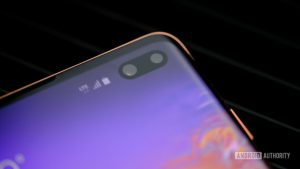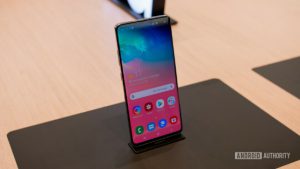 Not so long ago, a new generation of Samsung's flagship devices, the Galaxy S10, was introduced. Why devices? Because this year the company presented 4 modifications of the flagship at once. But among all the innovations, the main novelty is the company's new display, which they even gave a new name: Dynamic Amoled.
Not so long ago, a new generation of Samsung's flagship devices, the Galaxy S10, was introduced. Why devices? Because this year the company presented 4 modifications of the flagship at once. But among all the innovations, the main novelty is the company's new display, which they even gave a new name: Dynamic Amoled.
The Galaxy S10 has an Infinity-O display that has a small dot in the upper right corner of the screen, but that's not the only thing that this screen can surprise you with.
Features of Dynamic Amoled
Before we get to the technical specifications, let's take a look at some of the features of the new panel. The new displays have reached a whopping 1,200 nits of brightness, up 13% from last year's flagship Galaxy S9. The company claims that such a reserve of brightness will be enough to use the smartphone even when the sun is scorching directly into the screen.
The contrast of the display has reached values of 2,000,000: 1, which will allow to reproduce more accurately black and light shades. This parameter is calculated by measuring the difference between the minimum and maximum possible brightness that one pixel can produce. This made it possible to view HDR10 + content. By the way, Samsung was the first in the mobile industry to achieve this.
to the content
Color rendering
According to Samsung, the new displays with Dynamic AMOLED are capable of covering the entire DCI-P3 color space. In other words, the new screens offer near-perfect color reproduction for high-quality media content such as movies, which now use a wider range of colors than sRGB. True, Samsung panels have long supported DCI-P3, but only with the release of the new flagship did they receive the “Color Volume 100%” certificate. Previously, this certification was awarded to the Samsung QLED TV line.
Improved color reproduction was achieved by replacing organic matrix materials OLED (organic light emitting diodes), and not by changing the arrangement of RGB pixels, as was the case in all previous Samsung panels.
In addition to improved color reproduction, the new sensor has improved battery life, which is very important for smartphones with large screens and high resolution. For example, Samsung Galaxy S10 5G has a 6.7-inch screen.
The new matrix also supports dynamic display of HDR10 + tones for more accurate color reproduction. Using this technology means that video metadata is dynamic for individual scenes. The new flagships are able to use the new technology not only when playing video files, but also when recording video itself.

to the content
Less Blue Light with Comfort Display Technology
Eye fatigue from blue light from smartphones is a highly debated issue in electronic device user circles. Samsung has made efforts to address this issue with a new panel. The company has developed a new technology – Comfort Display. This technology has been certified by the international concern TÜVRheinland.
Comfort Display technology has increased the maximum wavelength of blue radiation from 450 nm to 465 nm. As a result, most of the blue light was removed from the danger zone, which was in the range of 415-455 nm. The emission of blue light in this range is what causes eye fatigue. It also reduced the blue emission spectrum from 11.8% in the Galaxy S8 and S9 to 6.9% in the Galaxy S10. The company assures that this does not affect the image quality in any way.
As with the company's previous devices, the Galaxy S10 has a special filter to adjust the amount of blue light. When this function is activated, 99% of blue light is removed from the screen. You can activate this feature in the quick settings panel, which can be found in the notification panel.

to the content
Dynamic AMOLED – the best matrix for smartphones today
Galaxy devices have always been famous for their high-quality screens, which receive significant improvements every new generation of devices. The Samsung Galaxy S10 has continued this tradition. Dynamic AMOLED can be called the best screen of the company today, and for many reasons.
In addition to the features described above, the new AMOLED – the matrix hides a lot more interesting things: an ultrasonic fingerprint scanner. Samsung is commendable, as they were able to fit a huge number of different sensors under the screens, which can surprise even the most selective users.
Summing up all of the above, we can safely say that the new Dynamic AMOLED – the screen is the best and breakthrough in the modern smartphone market. But for how long? Perhaps the new Samsung smartphone with flexible screens will break Dynamic AMOLED on all fronts. And we will find out only after the start of the official sales of this device. Follow the latest news on our website so as not to miss an overview of the company's future devices.
